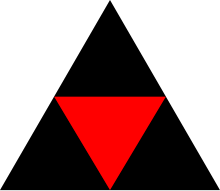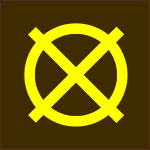3rd Division (United Kingdom)
The 3rd (United Kingdom) Division, known at various times as the Iron Division, 3rd (Iron) Division, Monty's Iron Sides or as Iron Sides;[3] is a regular army division of the British Army. It was created in 1809 by Arthur Wellesley, 1st Duke of Wellington, as part of the Anglo-Portuguese Army, for service in the Peninsular War, and was known as the Fighting 3rd under Sir Thomas Picton during the Napoleonic Wars. The division is also sometimes referred to as the Iron Division, a nickname earned during the bitter fighting of 1916, during the First World War. The division's other battle honours include: the Battle of Waterloo, the Crimean War, the Second Boer War, the Battle of France (1940) and D-Day landings of 6 June 1944. It was commanded for a time, during the Second World War, by Bernard Montgomery. The division was to have been part of a proposed Commonwealth Corps, formed for a planned invasion of Japan in 1945–46, and later served in the British Mandate of Palestine.
During the Second World War, the insignia became the "pattern of three" — a black triangle trisected by an inverted red triangle, created by Bernard Montgomery to instil pride in his troops.
Napoleonic Wars
Peninsular War
The division was part of the Allied British and Portuguese forces that took part in the Peninsular War. It fought at the Battle of Bussaco in September 1810,[4] the Battle of Fuentes de Oñoro in May 1811[5] and the Battle of El Bodón in September 1811,[6] before further combat at the Siege of Ciudad Rodrigo in January 1812,[7] the Siege of Badajoz in March 1812[8] and the Battle of Salamanca in July 1812.[9] It also fought at the Siege of Burgos in September 1812[10] and the Battle of Vitoria in June 1813.[11] It then pursued the French army into France and saw action at the Battle of the Pyrenees in July 1813,[12] the Battle of Nivelle in November 1813[13] and the Battle of the Nive in December 1813.[14] After that it fought at the Battle of Orthez in February 1814[15] and the Battle of Toulouse in April 1814.[16]
Peninsular War Formation
Battle of Vitoria example
Commanding General: Lieutenant-General Sir Thomas Picton (7,500)
- 1st Brigade (Maj-Gen Thomas Brisbane)
- 2nd Brigade (Maj-Gen Charles Colville)
- Portuguese Brigade (Maj-Gen Manley Power); See Military history of Portugal#Peninsular War (1807–1814)
- 1/9th Portuguese Infantry Regiment
- 2/9th Portuguese Infantry Regiment
- 1/21st Portuguese Infantry Regiment
- 2/21st Portuguese Infantry Regiment
- 11th Portuguese Caçadores Battalion
According to Picton, the fighting by the 3rd was so intense at the Battle of Vitoria, that the division lost 1,800 men (over one third of all Allied losses at the battle) having taken a key bridge and village, where they were subjected to fire by 40 to 50 cannons, and a counter-attack on the right flank (which was open because the rest of the army had not kept pace).[11] The 3rd held their ground and pushed on with other divisions to capture the village of Arinez.[11]
Waterloo Campaign
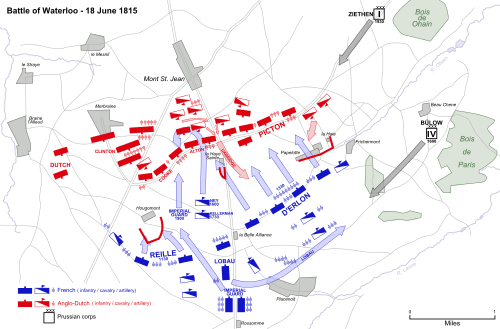
The 3rd Division was also present at the Battle of Quatre Bras and the Battle of Waterloo.in the Waterloo campaign under the command of Lieutenant-General Sir Charles Alten K.C.B. (Count Carl von Alten).[17]
Battle of Waterloo formation
5th Brigade
Major-General Sir Colin Halkett K.C.B.
- 2nd Battalion, 30th (Cambridgeshire) Regiment of Foot
- 1st Battalion, 33rd Regiment of Foot
- 69th (South Lincolnshire) Regiment of Foot
- 73rd Regiment of Foot
2nd Brigade, King's German Legion
Brevet Colonel Baron Christian Freiherr von Ompteda
- 1st Light Battalion
- 2nd Light Battalion
- 5th Line Battalion
- 8th Line Battalion
1st Hanoverian Brigade
Major-General Friedrich, Graf von Kielmansegge
- Field Battalion Bremen
- Field Battalion 1st Duke of York's
- Light Battalion Grubenhagen
- Light Battalion Lüneburg
- Field Battalion Verden
- Field Jaeger Battalion (two companies)
Artillery
Lieutenant Colonel John Samuel Williamson
- Lloyd's Field Brigade R. A. 5/390 5x9lb guns 1x5.5 inch Howitzer
- Cleeves' Field Brigade King's German Legion 6/209 5x9lb guns 1x5.5 inch Howitzer
Crimean War Formation
The 3rd Division took part in the Crimean War and fought in the Battle of Alma and the Siege of Sevastopol.
- Commanding General:Lieutenant-General Sir Richard England
- 5th Brigade: Brigadier-General Sir John Campbell
- 6th Brigade: Brigade-General William Eyre
- Two field batteries Royal Artillery
Second Boer War
During the Second Boer War (1899–1902) the division began under the command of General Gatacre but was subsequently partially absorbed into the Natal Field Force under the command of General Francis Clery.
In 1902 the army was restructured, and a 3rd Infantry division was established permanently at Bordon as part of the 1st Army Corps, comprising the 5th and 6th Infantry Brigades.[18][19]
First World War

During the First World War the 3rd Division was a permanently established Regular Army division that was amongst the first to be sent to France at the outbreak of the war as part of the British Expeditionary Force (BEF). The 3rd Division served on the Western Front in France and Belgium for four years, from 1914 to 1918. During this time, it was nicknamed "The Iron Division". Its first commander during the war, Major-General Hubert Hamilton, was killed by shellfire near Béthune in October 1914. The division served in many major battles of the war, including the Battle of Mons and the subsequent Great Retreat, and later the First Battle of Ypres, which saw the pre-war Regular Army all but destroyed, with the 3rd Division suffering considerably.
Order of battle
During the Great War the 3rd Division's composition was as follows:[20]
- 7th Brigade (to 18 October 1915)
- 3rd Battalion, Worcestershire Regiment
- 2nd Battalion, South Lancashire Regiment
- 1/4th Battalion, South Lancashire Regiment
- 1st Battalion, Wiltshire Regiment
- 2nd Battalion, Royal Irish Rifles
- 1/1st Battalion, Honourable Artillery Company
The brigade moved to the 25th Division in October 1915 and was replaced by the 76th Brigade.
- 2nd Battalion, Royal Scots
- 8th (Service) Battalion, East Yorkshire Regiment
- 7th (Service) Battalion, King's Shropshire Light Infantry
- 1st Battalion, Royal Scots Fusiliers
The following battalions joined the brigade for periods in 1914 and 1915.
- 2nd Battalion, Royal Irish Regiment (from August 1914 to March 1915)
- 4th Battalion, Middlesex Regiment (from August 1914 to November 1915)
The following battalions joined the brigade for periods in 1915 and 1916.
- 13th (Service) Battalion, King's (Liverpool Regiment) (from October 1915 to April 1916)
- 1/5th (City of London) Battalion, London Regiment (from October 1915 to February 1916)
The following battalions left the brigade for the 76th Brigade when it joined the division in October 1915:
- 2nd Battalion, Suffolk Regiment (from October 1914)
- 1st Battalion, Gordon Highlanders (from August 1914)
- 1/4th Battalion, Gordon Highlanders (from February 1915)
- 1st Battalion, Northumberland Fusiliers
- 4th Battalion, Royal Fusiliers
- 1st Battalion, Lincolnshire Regiment (until November 1915)
- 1st Battalion, Royal Scots Fusiliers (until April 1916, then to 8th Brigade)
- 1/10th (Scottish) Battalion, King's (Liverpool Regiment) (from November 1914 to January 1916)
- 12th (Service) Battalion, West Yorkshire Regiment (from November 1915 to February 1918)
- 13th (Service) Battalion, King's (Liverpool Regiment) (joined from 8th Brigade in April 1916)
- 9th Brigade Machine Gun Company (formed in February 1916, joined the 3rd MG Battalion, Machine Gun Corps in March 1918)
- 9th Trench Mortar Battery (joined by May 1916)
The brigade served with the 3rd Infantry Division throughout the war, except for a brief a period in early 1915 when it exchanged places with the 85th Brigade of 28th Division.
- 76th Brigade (from 15 October 1915)
- 8th (Service) Battalion, King's Own (Royal Lancaster Regiment)
- 13th (Service) Battalion, King's (Liverpool Regiment)
- 10th (Service) Battalion, Royal Welsh Fusiliers
- 2nd Battalion, Suffolk Regiment
- 1st Battalion, Gordon Highlanders
- 1/4th Battalion, Gordon Highlanders (until February 1916)
The brigade joined the division from the 25th Division in October 1915.
Between the wars
After the end of the First World War, the division was stationed in southern England where it formed part of Southern Command. In 1937, one of its brigades, the 9th Infantry Brigade, was commanded by Brigadier Bernard Montgomery. He assumed command of the 3rd Division shortly before Britain declared war on Nazi Germany in September 1939.
Second World War
The 3rd Infantry Division, under the command of Major General Bernard Montgomery, was sent overseas to France in late September 1939, just under a month after the outbreak of the Second World War.[21] There the division became part of Lieutenant General Alan Brooke's II Corps of the British Expeditionary Force (BEF).[21] However, unlike in the First World War, where the division was almost immediately engaged in desperate fighting, there was no action. Montgomery instantly began training the men of his division in a tough training regime. As with most of the rest of the BEF, training was severely hampered by a shortage of modern equipment.[22]
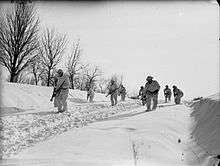

In May 1940, after several months of relative inactivity, the German Army launched its attack in the west which resulted in the BEF being split up from the French Army, evacuated from Dunkirk. Due to Montgomery's strict training regime, the 3rd Division suffered comparatively few casualties and earned a reputation as one of the best British divisions in France. During the evacuation Montgomery was promoted to temporary command of II Corps and Brigadier Kenneth Anderson took temporary control of the division before, in July, Major General James Gammell assumed command.[21]
Composition 1939–40
From the outbreak of war on 3 September 1939 until the Battle of Dunkirk and subsequent evacuation at Dunkirk in May 1940 the composition of the 3rd Infantry Division was as follows:[23]
General Officer Commanding: Major-General Bernard Montgomery[24][25]
- 1st Battalion, Grenadier Guards
- 2nd Battalion, Grenadier Guards
- 1st Battalion, Coldstream Guards
- 7th Guards Brigade Anti-Tank Company
- 1st Battalion, Suffolk Regiment
- 2nd Battalion, East Yorkshire Regiment
- 2nd Battalion, Gloucestershire Regiment (until 5 February 1940)
- 4th Battalion, Royal Berkshire Regiment (Territorial Army) (from 5 February 1940)
- 8th Infantry Brigade Anti-Tank Company
- 2nd Battalion, Lincolnshire Regiment
- 1st Battalion, King's Own Scottish Borderers
- 2nd Battalion, Royal Ulster Rifles
- 9th Infantry Brigade Anti-Tank Company
Divisional Troops[23]
- 15th/19th The King's Royal Hussars (until 31 March 1940)
- 7th Field Regiment, Royal Artillery
- 23rd Field Regiment, Royal Artillery (until 5 March 1940)
- 33rd Field Regiment, Royal Artillery
- 76th (Highland) Field Regiment, Royal Artillery (Territorial Army) (from 5 March 1940)[29]
- 20th Anti-Tank Regiment, Royal Artillery
- 246th Field Company, Royal Engineers
- 248th Field Company, Royal Engineers (until 2 November 1939)
- 253rd Field Company, Royal Engineers
- 17th Field Company, Royal Engineers (from 2 November 1939)
- 15th Field Park Company, Royal Engineers
- 3rd Division Signals, Royal Corps of Signals
- 8th Battalion, Royal Northumberland Fusiliers (Territorial Army) – (Motorcycle Battalion)
- 2nd Battalion, Middlesex Regiment – (Machine Gun Battalion) (CO: Lieutenant Colonel Brian Horrocks)[30][31]
Composition 1940–44
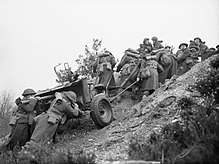
For over a year after Dunkirk the composition of 3rd Division remained largely unchanged (except that the motorcycle battalion was converted into 3rd (RNF) Reconnaissance Regiment, Reconnaissance Corps). Then, in September 1941, the 7th Guards Brigade was transferred to help create the Guards Armoured Division, and, in November, the 37th Infantry Brigade Group joined the 3rd Division and was renumbered 7th Brigade with the following composition:[23][32]
7th Infantry Brigade
- 2nd Battalion, South Wales Borderers
- 2/6th Battalion, East Surrey Regiment
- 6th Battalion, Royal Sussex Regiment
- 7th Infantry Brigade Anti-Tank Company
The brigade anti-tank companies were disbanded during 1941 and 92nd (Loyals) Light Anti-Aircraft Regiment, Royal Artillery, formerly the 7th Battalion, Loyal Regiment (North Lancashire), joined the division in March 1942.
In June 1942, 3rd Infantry Division was reorganised as a 'Mixed' Division, with 33rd Tank Brigade replacing 7th Infantry Brigade:
33rd Tank Brigade[33]
By early 1943, the experiment with 'mixed' divisions was abandoned, and 3rd Division reverted to being an infantry formation, 33rd Tank Brigade being replaced by 185th Infantry Brigade, composed of the 2nd Royal Warwicks, 1st Royal Norfolks and 2nd KSLI, from the 79th Armoured Division:[23][34] Shortly after this the division was originally intended to join the British Eighth Army in the invasion of Sicily but this was given to the 1st Canadian Infantry Division instead. By May 1944 the 3rd British Infantry Division (which it was called to avoid confusion with the 3rd Canadian Infantry Division) had the following composition:
- 1st Battalion, Suffolk Regiment
- 2nd Battalion, East Yorkshire Regiment
- 1st Battalion, South Lancashire Regiment
- 2nd Battalion, Lincolnshire Regiment
- 1st Battalion, King's Own Scottish Borderers
- 2nd Battalion, Royal Ulster Rifles
- 2nd Battalion, Royal Warwickshire Regiment
- 1st Battalion, Royal Norfolk Regiment
- 2nd Battalion, King's Shropshire Light Infantry
Divisional Troops
- 2nd Battalion, Middlesex Regiment – Machine Gun Battalion
- 3rd Reconnaissance Regiment, Reconnaissance Corps
- 7th Field Regiment, Royal Artillery
- 33rd Field Regiment, Royal Artillery
- 76th (Highland) Field Regiment, Royal Artillery
- 20th Anti-Tank Regiment, Royal Artillery
- 92nd (Loyals) Light Anti-Aircraft Regiment, Royal Artillery
- 17th Field Company, Royal Engineers
- 246th Field Company, Royal Engineers
- 253rd Field Company, Royal Engineers
- 15th Field Park Company, Royal Engineers
- 3rd Division Signals Regiment, Royal Corps of Signals
Thus the division had attained the organisation with which it went into action on D-Day.
D-Day
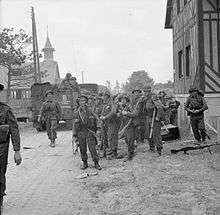
The 3rd British Infantry Division was the first British formation to land at Sword Beach on D-Day, 6 June 1944, as part of the invasion of Normandy, part of the larger Operation Overlord. For the assault landing, 3rd British Division was organised as a Division Group, with other formations temporarily under its command. These included 27th Armoured Brigade (Sherman DD amphibious tanks) and 22nd Dragoons (Sherman Crab flail tanks), 1st Special Service Brigade and No. 41 (Royal Marine) Commando, 5th Royal Marine Independent Armoured Support Battery (Centaur IV close support tanks), 77 and 79 Assault Squadrons of 5th Assault Regiment, Royal Engineers (Churchill AVREs), plus additional Royal Engineers, Royal Artillery and Royal Army Service Corps personnel.
The division's own artillery were all self-propelled (field regiments: M7 Priest;[29][36][37][38] anti-tank regiment: M10 tank destroyer[39][40]) and the SP field guns and RM Centaurs were able to fire from their landing craft during the run-in to the beach. In addition, 3rd British Division had 101 Beach Sub-Area HQ and Nos 5 and 6 Beach groups under command for the assault phase: these included additional engineers, transport, pioneers, medical services and vehicle recovery sections.[41][42]
The 3rd Division's brigades were organised as brigade groups for the assault, with 8 Brigade Group making the first landing, followed by 185 Brigade Group and 9 Brigade Group in succession during the morning and early afternoon.[41]
After D-Day
After D-Day the 3rd Infantry Division fought through the Battle for Caen, in Operation Charnwood and Operation Goodwood. With the fighting in Normandy over after the Battle of the Falaise Gap, the division also participated in the Allied advance from Paris to the Rhine and fought in the Netherlands and Belgium and later the Allied invasion of Germany. For the campaign in Normandy, the division was commanded by Major-General Tom Rennie until he was wounded on 13 June 1944; Major-General 'Bolo' Whistler, a highly popular commander, took command on 23 June 1944.[43] During the campaign in Normandy, the division won its first Victoria Cross of the Second World War, awarded in August 1944 to Corporal Sidney Bates of 1st Battalion, Royal Norfolk Regiment, part of the 185th Brigade. Private James Stokes of the 2nd Battalion, King's Shropshire Light Infantry, also of the 185th Brigade, was the second recipient awarded the Victoria Cross in March 1945.[44] Both awards were posthumously.
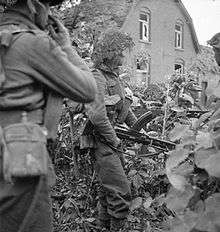
During the often intense fighting from Sword Beach to Bremen, the 3rd Division suffered 2,586 killed with over 12,000 wounded.[45] In Normandy alone the 3rd Division suffered over 8,000 casualties, 3,500 of them being within the first three weeks of fighting after D-Day.
After the fighting in Europe was over, the 3rd Division was selected to form a Commonwealth Corps together with an Anzac and a Canadian division to assault Japan alongside the Americans. Fortunately for the men of the 3rd Division the Japanese surrendered. If they hadn't, it seems likely that the 3rd Division may well have suffered many more heavy casualties in the invasion.
Post Second World War
Postwar, the division was reformed on 1 April 1951, in the Suez Canal Zone, under the command of Sir Hugh Stockwell. The division became part of Middle East Land Forces. It consisted of three recently reraised brigades, the 32nd Guards, the 19th Infantry, and the 39th Infantry. It served in the UK for many years and was part of the Army Strategic Command in 1968. It had elements of 5th, 19th, and 24th Brigades attached to it.[46]
During the 1970s the division consisted of two "square" brigades, the 6th Armoured Brigade and 33rd Armoured Brigade.[47] It became 3rd Armoured Division in 1976 and served with I (BR) Corps being based at St Sebastian Barracks in Soest near the Möhne Dam from 1977.[48] After being briefly reorganised into two "task forces" ("Echo" and "Foxtrot") in the late 1970s, it consisted of the 4th Armoured Brigade, the 6th Airmobile Brigade and the 19th Infantry Brigade in the 1980s.[49]
1993 to 2014
The division was given a new role as a mechanised division, becoming 3rd Mechanised Division with headquarters at Bulford, Wiltshire, in 1992.[50] It provided the headquarters for Multi-National Division (South-West) in Bosnia-Herzegovina in 1995 / 1996 and again in 1998.[51] At that time it comprised 1st Mechanised Brigade, 5th Airborne Brigade, and 19th Mechanised Brigade.
On 1 September 1999 the division was freed from its administrative and regional responsibilities and became a deployable or "fly-away" division.[52] As 3rd (UK) Mechanised Division it was the only division at continual operational readiness in the United Kingdom (the other at operational readiness being 1st (UK) Armoured Division in Germany). It was based at Picton Barracks, Bulford Camp, and reported to the Commander Land Forces at Andover.
The following brigades made up the 3rd (UK) Mechanised Division during that period:[53]
- 1st Mechanized Brigade
- 4th Mechanized Brigade
- 12th Mechanized Brigade
- 3rd Division Headquarters and Signal Regiment
- 5 Regiment Army Air Corps (Lynx)
- 36 Engineer Regiment, Royal Engineers
- 3 Regiment, Royal Military Police
- The Royal Wessex Yeomanry
Current formation
Under Army 2020, the division was renamed as 3rd (United Kingdom) Division and will continue to be based at Bulford Camp, and command the Reaction Force, which comprises:[54][55]
- 1st Armoured Infantry Brigade
- 12th Armoured Infantry Brigade
- 20th Armoured Infantry Brigade
- 101 Logistic Brigade
- Royal Wessex Yeomanry (Army Reserve - Challenger 2 crew replacements for the armoured regiments of the division's brigades)
_Division_2018.png)
Recipients of the Victoria Cross
- This along with a * indicates a posthumous award
General Officers Commanding
Commanders have been:[56]
Major General Commanding 3rd Division
- 1902–? Major-General Sir Bruce Hamilton[57]
GOC 3rd Division
- 1907–1910 Major-General William Franklyn
- 1910–1914 Major-General Henry Rawlinson
- May 1914 – Oct 1914 Major-General Hubert Hamilton
- Oct 1914 Major-General Colin Mackenzie
- 1914–1916 Major-General Aylmer Haldane
- 1916–1919 Major-General Cyril Deverell
- 1919–1922 Major-General Robert Whigham
- 1922–1926 Major-General William Heneker
- 1926–1930 Major-General John Burnett-Stuart
- 1930–1932 Major-General Harry Knox
- 1932–1934 Major-General Walter Pitt-Taylor
- 1934–1936 Major-General Robert Gordon-Finlayson
- 1936 Major-General Cecil Heywood
- 1936–1939 Major-General Denis Bernard
- 1939–1940 Major-General Bernard Montgomery
- 1940–1941 Major-General James Gammell
- 1941–1942 Major-General Eric Hayes
- 1942–1943 Major-General William Ramsden
- 1943–1944 Major-General Tom Rennie
- 1944–1947 Major-General Lashmer Whistler
- 1951–1952 Major-General Hugh Stockwell
- 1952–1954 Major-General Nigel Poett
- 1954–1957 Major-General John Churcher
- 1957–1959 Major-General George Gordon-Lennox
- 1959–1961 Major-General Charles Harington
- 1961–1962 Major-General Vivian Street
- 1962–1964 Major-General Michael Carver
- 1964–1966 Major-General Cecil Blacker
- 1966–1968 Major-General Anthony Deane-Drummond
- 1968–1970 Major-General Terence McMeekin
- 1970–1972 Major-General Glyn Gilbert
- 1972–1974 Major-General Richard Worsley
- 1974–1976 Major-General Robin Carnegie
GOC 3rd Armoured Division
- 1976–1978 Major-General Michael Walsh
- 1978–1980 Major-General Henry Dalzell-Payne
- 1980–1982 Major-General Norman Arthur
- 1982–1984 Major-General Antony Walker
- 1984–1987 Major-General David Ramsbotham
- 1987–1988 Major-General Edward Jones
- 1988–1990 Major-General Michael Wilkes
- 1990–1992 Major-General Christopher Wallace
GOC 3rd (UK) Division
- 1992–1994 Major-General Hew Pike
- 1994–1996 Major-General Mike Jackson
- 1996–1999 Major-General Cedric Delves
GOC 3rd (UK) Mechanised Division
- 1999–2000 Major General Richard Dannatt
- 2000–2003 Major General John McColl
- 2003–2005 Major General Graeme Lamb
- 2005–2007 Major General Richard Shirreff
- 2007–2009 Major General Barney White-Spunner
- 2009–2011 Major General James Everard
- 2011–2013 Major General John Lorimer
- 2013–2014 Major General James Cowan
GOC 3rd (United Kingdom) Division
- 2014–2015 Major General James Cowan
- 2015–2016 Major-General Patrick Sanders
- 2016–Present Major-General Nick Borton
Brigadier General Douglas Crissman of the United States Army has been assigned as Deputy Commanding General of the Division.[58] This is part of the growing practice for senior officers of the British Army and the United States Army to be assigned as deputy commanders (and effectively liaison officers) in each other's operational units.[59]
See also
Notes
- ↑ Cole p. 36
- ↑ Chappell p. 8
- ↑ Delaforce
- ↑ Cannon, p. 48
- ↑ Cannon, p. 56
- ↑ Cannon, p. 59
- ↑ Cannon, p. 61
- ↑ Cannon, p. 65
- ↑ Cannon, p. 73
- ↑ Cannon, p. 77
- 1 2 3 Cannon, p. 81
- ↑ Cannon, p. 90
- ↑ Cannon, p. 92
- ↑ Cannon, p. 93
- ↑ Cannon, p. 95
- ↑ Cannon, p. 99
- ↑

- ↑ Rinaldi, p. 31
- ↑ "Naval & Military intelligence - The 1st Army Corps". The Times (36892). London. 7 October 1902. p. 8.
- ↑ Baker, Chris. "The 3rd Division in 1914–1918". The Long, Long Trail. Retrieved 10 July 2014.
- 1 2 3 Joslen, p. 43-44
- ↑ "badge, formation, 3rd Infantry Division". Imperial War Museum. Retrieved 4 August 2017.
- 1 2 3 4 Joslen, pp. 43–4.
- ↑ Keegan, pp. 148–165.
- ↑ Montgomery, pp. 49–70.
- ↑ Joslen, p. 243.
- 1 2 Joslen, p. 246.
- 1 2 Joslen, p. 247.
- 1 2 "RA 1939–45 76 Fld Rgt". Ra39-45.pwp.blueyonder.co.uk. Archived from the original on 18 December 2014. Retrieved 2013-01-19.
- ↑ Horrocks, pp. 76–92.
- ↑ Keegan, pp. 225–241.
- ↑ Joslen, p. 286.
- ↑ Joslen, p. 206.
- ↑ Joslen, pp. 30, 360.
- ↑ Joslen, p. 360.
- ↑ Ellis, p. 542.
- ↑ "RA 1939–45 7 Fld Rgt". Ra39-45.pwp.blueyonder.co.uk. Archived from the original on 24 April 2012. Retrieved 2013-01-19.
- ↑ "RA 1939–45 33 Fld Rgt". Ra39-45.pwp.blueyonder.co.uk. Archived from the original on 22 May 2014. Retrieved 2013-01-19.
- ↑ Ellis, p. 546.
- ↑ "RA 1939–45 20 A/Tk Rgt". Ra39-45.pwp.blueyonder.co.uk. Archived from the original on 24 April 2012. Retrieved 2013-01-19.
- 1 2 Ellis, pp. 173, 184–6.
- ↑ Joslen, pp. 584–5.
- ↑ Delaforce, p. .
- ↑ "James Stokes". Commonwealth War Graves Commission. Retrieved 18 July 2014.
- ↑ Delaforce, p. 206.
- ↑ Blaxland
- ↑ Watson, Graham (2005). "The British Army in Germany: An Organisational History 1947–2004". Tiger Lily. p. 95.
- ↑ "St Sebastian Barracks". BAOR Locations. Retrieved 27 October 2015.
- ↑ Black, Harvey. "The Cold War Years. A Hot War in reality. Part 6".
- ↑ "3rd Division". Global Security. Retrieved 27 October 2015.
- ↑ Conrad, John (2011). Scarce Heard Amid the Guns: An Inside Look at Canadian Peacekeeping. Natural Heritage Books. ISBN 978-1-55488-981-5.
- ↑ Soldier Magazine, December 1998, p.13
- ↑ British Army Units
- ↑ Army basing plan
- ↑ Army 2020 Brochure Archived 18 April 2013 at the Wayback Machine.
- ↑ Army Commands Archived 5 July 2015 at the Wayback Machine.
- ↑ "Army Corps appointments". The Times (36871). London. 12 September 1902. p. 6.
- ↑ "General Officer Assignments". United States Department of Defense. 25 March 2016. Retrieved 11 April 2017.
- ↑ Stairrett, Amanda Kim (25 November 2013). "2nd British general officer takes post with 'BRO'". Fort Riley, Kansas: 1st Infantry Division. Retrieved 3 September 2015.
References
- Blaxland, Gregory (1971) The Regiments Depart: A History of the British Army 1945–70, London: William Kimber.
- Cannon, Richard (1851). Historical Record of the Seventy-Fourth Regiment (Highlanders) containing account of the formation of the regiment in 1787 and of its subsequent services to 1850. London: Parker, Furnivall and Parker.
- Chappel M., (1986) British Battle Insignia (1). 1914-18 Osprey Publishing ISBN 9780850457278
- Cole, Howard (1973). Formation Badges of World War 2. Britain, Commonwealth and Empire. London: Arms and Armour Press.
- Delaforce, Patrick (1995) Monty's Iron Sides, Stroud: Alan Sutton, ISBN 0-7509-0781-9,
- Ellis, Major L.F. (2004) History of the Second World War: United Kingdom Military Series: Victory in the West, Volume I: The Battle of Normandy, London: HMSO, 1962/Uckfield: Naval & Military, ISBN 1-84574-058-0.
- Horrocks, Lt-Gen Sir Brian, (1960) A Full Life, London: Collins.
- Joslen, Lt-Col H.F. (2003) Orders of Battle, United Kingdom and Colonial Formations and Units in the Second World War, 1939–1945, London: HM Stationery Office, 1960/Uckfield: Naval & Military, ISBN 1-84342-474-6.
- Keegan, John (1991), Churchill's Generals, London: Weidenfeld & Nicolson.
- Montgomery, Field Marshal Viscount, (1958) Memoirs, London: Collins.
- Rinaldi, Richard (2008). Order of Battle of the British Army 1914. General Data. ISBN 978-0982054116.
- Scarfe, Norman (2006) [1947]. Assault Division: A History of the 3rd Division from the Invasion of Normandy to the Surrender of Germany. Stroud, Gloucestershire: Spellmount. ISBN 1-86227-338-3.
External links
- 3rd (UK) Division- on British Army official website
